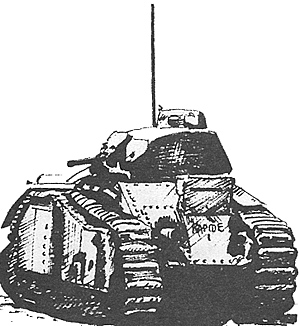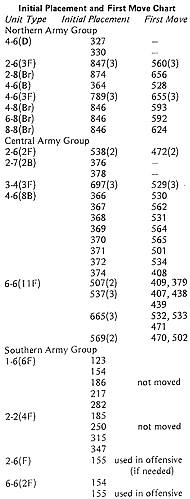 A French victory with the Historic Order
of Battle (O.B. # 11) in France, 1940 seems to
be a difficult assignment for many of us
armchair generals. But an allied victory here is
not as hard as it seems. This victory is not a
stalemate but a victory, point-wise, for the Allies
over the Germans.
A French victory with the Historic Order
of Battle (O.B. # 11) in France, 1940 seems to
be a difficult assignment for many of us
armchair generals. But an allied victory here is
not as hard as it seems. This victory is not a
stalemate but a victory, point-wise, for the Allies
over the Germans.
The French must play their position very aggressively. They must establish a strong line defensive position. This will turn the battle to attrition, thus preventing the Germans from establishing a mobile battle, For in a mobile battle the Germans will easily win. The French must force the Germans into an attrition situation.
Initial Placement
For this the French must set-up a hard
line of defense in Belgium, Luxemburg, and the
Netherlands, with the Maginot Line to the south.
Although the French must attrition the Germans;
their aggressive policy forces them to attack
weak German positions.
 The initial set-up by the Allies is of
supreme importance, for it is the initial set-up
which will ensure a successful attrition battle in
Belgium, Luxemburg, and the Netherlands. The
basic strategy is for the neutral nations to delay
the German advance. This will allow the British
and French forces to move forward and form a
defensive line mainly in Belgium and the
Netherlands. (This may sound quite like the Dyle
Plan, but it is not.)
The initial set-up by the Allies is of
supreme importance, for it is the initial set-up
which will ensure a successful attrition battle in
Belgium, Luxemburg, and the Netherlands. The
basic strategy is for the neutral nations to delay
the German advance. This will allow the British
and French forces to move forward and form a
defensive line mainly in Belgium and the
Netherlands. (This may sound quite like the Dyle
Plan, but it is not.)
The neutral forces ability to delay the Germans, is the key for the French being able to establish their defensive lines in the easily defended areas of Belgium and the Netherlands. The Netherlands are in the weakest position of the game, and the German will usually eliminate these forces during the first turn. In order for the Netherlands to effectively delay the Germans, they must set-up in the Peel Marches.
The German will have to utilize some of his air power in this area in order to offset the defensive advantage. The marches and the forest will greatly hamper the German armor's push into the plains in Belgium during their mechanized movement phase after the annihilation of the forces in the Netherlands. The Belgium forces must be set-up in a line, containing both hexes of fortress Eben Emael, which must be occupied. This cannot be over stressed, for if Eben Emael were to be destroyed by parachute units a later offensive could not be made. Thus this would ruin our strategy.
The British set-up is part of the French set- up, but because of the' movement rate of the British is high, they have the furthest to go in order to establish their lines. The British air unit should be placed in or around (within 5 or 6 hexes) of Dunkirk. The British 4-8, 6-8, and 8-8 infantry are placed on hex 846, this allows the British to come close to the Belgium-Netherlands border, and the forest in that area.
The British 2-8 infantry is placed on hex 874, this also gives this unit capability of joining the other British units in establishing the northern defensive line.
The French put very little to the north, but most of their units are placed in the central region, and then some in the south. The French send all three of their 4-6 armor, and three of their 2-6 mechanized infantry units to the north. It can be seen that the northern army group is quite strong, and they will usually win back territory in the Netherlands.
The central army group is the largest because it has the largest area to cover. This group contains eleven 6-6 in- fantry, three 3-4 armor, two 2-6 mechanized infantry, and the remainder of the Belgian forces. The southern army group is by far the weakest unit numerically, but the strongest defensively because of the Maginot Line. It consists of five 1-6 armored cavalry, four 2-2 infantry, one 2-6 mechanized in- fantry, and two 6-6 infantry. These two 6-6 infantry units are stationed here to threaten the German's southern flank.
All of the Maginot hexes except for the two most western hexes are occupied to prevent an easy conquering by parachute units, and the exploitation by armor and infantry into the southern plains of France. The French air unit is placed on hex 887, near Soissons. This gives it the capability to cover parts of both the central and southern army groups.
The British air unit covers the northern army group and parts of the central army group, thus almost the whole front is covered by air power.
After the German's first turn the Allies must, on their first turn, establish their defensive line. (As shown in the Initial Set-up and First Move Chart.) The Allies will lose a lot of units in turns two through eight. Although the French should win, the German losses in the same time will be less. In unit strength points the Germans could be winning by as much as two to one. This should not discourage the French player.
The French must hold fast to his area, giving up territory only when units in those hexes are exposed to attack from four or more hexes. The French player must not create too many corner hexes that can be attacked from three hexes.
Early Turns
During the early turns, the northern army group must force their way into the forest in northern Belgium, This is because of the favorable defensive qualities of a forested 2 area. The German player would have to use air support here to counter the defensive advantages of fighting in a forested area. With most of the central army group in the Ardennes, he will have to use air power here also. The central army group must try to occupy hexes 496 and 497 in the central plains of Belgium. For these also possess defensive qualities that the French must take advantage of. The Allies must try to maintain this position. But in the north he should try to gain territory in the Netherlands. The central army group, with the units that are in the Ardennes, should try to create a bulge in the German lines.
The French, in the middle of the game (turns 4-6), may see his line deteriorating. This may cause him to worry, because, with his forward positions, his reinforcements will not arrive for a few turns after they are allotted. It is very important for him to hold his positions. The Allies must hold on, no matter how bad it looks. It will not collapse until the Allied part of turn ten. The Allies also must not try to execute a series of short retreats, to "save" his forces.
About turn six the Allies should start their offensive in the south and the Ardennes. The two 6-6 French infantry units in the Maginot Line, must make their moves. If the German has left the area to the north of the Maginot Line lightly defended they should attack directly out of the Maginot Line into Germany, or very eastern Luxemburg. But if it is heavily defended with 7-6 infantry units the two 6-6's should move directly to the central army group in the Ardennes (this can be done earlier if necessary). The French should at this time be establishing their bulge in the Ardennes.
The battle of the bulge (I am not referring to the historic battle) should terminate in turn seven or eight. The termination is climaxed by pushing several Allied units behind the German lines, The Germans of course, will quickly close the hole and he will think that they are now out of supply, and that they are of no threat. By this time the German player has stopped receiving reinforcements, so in order for him to counter this he would have to pull units off the fronts. If the units behind the lines are in supply from the Maginot Line then all the units should go after German air units, since they are worth ten victory points.
If supply from the Maginot Line is impossible because the German has cut those supply lines, then the movement rate of all units must be cut in half. This will deceive the German. Supply for two corps equivilent is possible from fortress Eben Emael (this is why it was so important to not have the fort destroyed). Eben Emael, as a source of supply must not be revealed until turn nine.
The units which Eben Emael supply should be two 6-6 infantry, which are going after or attacking German air units. If Eben Emael is disclosed to the German before this time, he will be able to encircle it, thus ending it's supply capabilities.
The end has now been set for, and in the favor of the French. Game turn nine is an important turn as it signals the start of the Allies grand offensive. In turn nine the Allies should attack wherever the results are AR, CA, 7 GA, and DX The northern army group, if successful, may try to encircle the Germans, at the point where the northern and central army groups meet. This, however, is usually unlikely. The French must still hold their lines in turn nine, because the Germans, if successfully held up in Belgium, will try almost anything to achieve his victory conditions.
After the German's part of turn ten, the Germans are finished for this game. So the defensive position for the French is now over. The Allies should take full advantage of the German's position, by attacking. It is now time for the, "Grand Offensive."
The French should use some of his units that are behind the German's line, in cooperation with other French and Allied units, to attack the Germans from both sides. This means that if the German has to retreat from a combat result, the chances are that he will be eliminated. The units behind the lines that are attacking air units will have greatly helped the Allied war effort, as it will disrupt the German air support. It is now in turn ten that the French lines collapse, and this is planned. The massive attack in the end of the game should win it for the French.
This strategy is not perfect and it will sometimes lose, but most of the time it will mean a victory for the Allies. The strategy also does not have to be followed exactly as written, -is it is flexible. For if the Germans would attack in a novel manner, the Allies defense will have to compensate for this. Although the idea of the French collapsing their lines on May 28-29 in real life is preposterous, because this is a game we do have the advantage, that at the end we do not have to worry about the turn after the last turn, as we are finished fighting.
Back to Campaign # 72 Table of Contents
Back to Campaign List of Issues
Back to MagWeb Master Magazine List
© Copyright 1976 by Donald S. Lowry
This article appears in MagWeb (Magazine Web) on the Internet World Wide Web. Other military history articles and related product articles are available at http://www.magweb.com